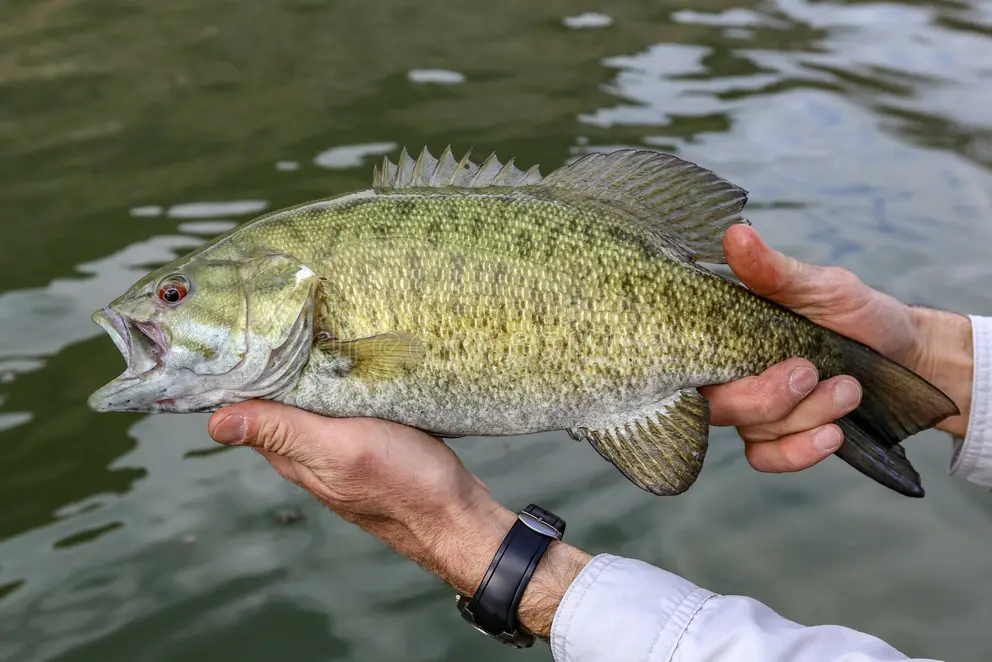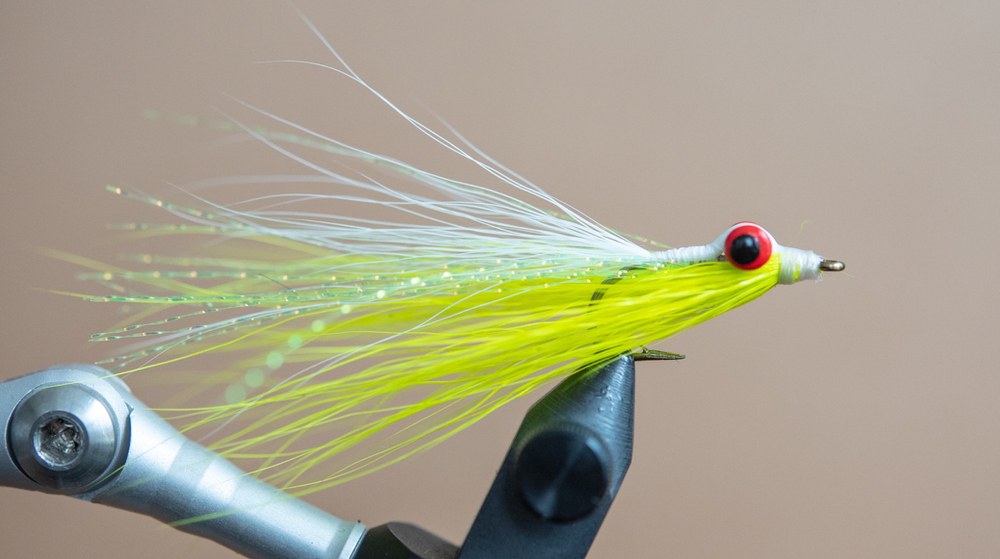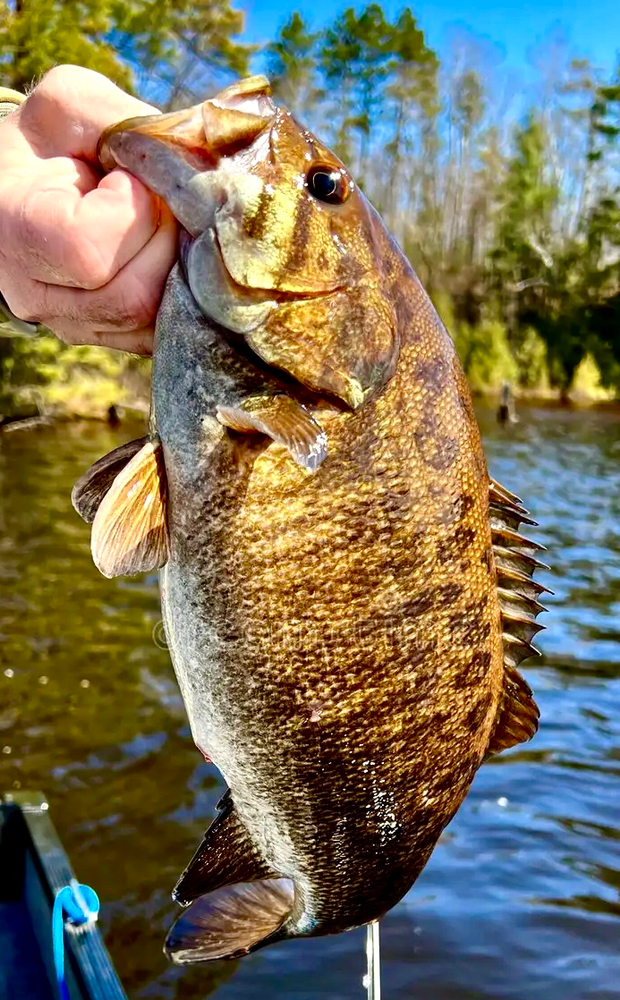Dave Wolf: Smallmouth Bass on the Fly are the Way to Go

Smallmouth bass might be the way to go. Bob Clouser, well known for his fly patterns, the most famous being the “Clouser Minnow,” and I both guided on the Susquehanna River. Bob always fished the middle section of the river where the pools were deeper. I guided by using a drift boat in the mid to upper reaches. I always used popping bugs to take bass, while Bob used his Clouser minnow and other deep-water patterns. When he fished my portion of the river, he did take bass but not as many as my poppers brought to the net.
Of course, I found Bob to be a better fly fisher than me, but as usual, Bob began developing a series of foam-popping bugs. I’m always willing to learn from others and his visit spurred my interest.
I began to use his crayfish patterns with great success, especially when the water was high. But my insistence on using topwater bugs probably lowered my count considerably.
My guiding ended when I tore my rotator cuff and pulled my rib cage from my body. This happened when one of the oars hit a rock, as I was trying to maneuver the boat between some large boulders to allow it to follow a small run. One of my clients was standing and despite me telling him to sit down, he didn’t listen. The impact nearly threw me out of the boat.
I remember sitting on the bank with my arm in a sling and showing others where the better water was located. One man came from Ohio and wanted me to show him how to fish Gaines Poppers correctly. He paid me what I considered way too much money but insisted I keep it. We only fished for a few short hours but he was able to catch at least 12 bass.
After a huge die-off of smallmouth, the Susquehanna River was like a tomb. I counted thousands of dead and dying fish. I was heartbroken. I thought the river would never come back to anything close to its original self, but slowly the river began to return.
First, the Little Juniata began showing signs of improvement. Anglers began to flock there and most abandoned the Susquehanna entirely. Then the Fish and Boat Commission put restrictions on both rivers. Today the better part of both rivers is catch and release only.

Add a Clouser Minnow To Your Fly Box!
Smallmouth Bass Spawning Habits and Behavior
The smallmouth bass was native to and found only in the Great Lakes and Ohio River watersheds until the mid-1800s. When the railroads spread around the country in the second half of the 19th century, so did the smallmouth. It was transported by train and eventually became a popular sport fish throughout the United States. It is now found all across Pennsylvania.
Because of its body’s brownish-gold tints, the smallmouth has been nicknamed “bronzeback.” Its species name recognizes a French naturalist, M. Dolomieu. Although largemouths and smallmouths may live in the same rivers or lakes, they are found in different habitats. Smallmouths prefer rocky locations, more water depth, and heavier currents than largemouths.
In Pennsylvania, smallmouth bass are found in medium to large streams and clear, deep lakes and reservoirs with a summer water temperature between 60 and 80 degrees. In lakes, they hang around downed logs, stumps, stone rubble, and rock outcrops, and along the steep sides of submerged creek channels.
They prefer streams with riffles flowing over gravel or boulders, where they are found in the pools, and pockets behind rocks, or the deeper moving water.
Smallmouth bass spawn in spring, May to early June, when water temperatures reach 60 to 70 degrees. The male builds the nest. The male fans a circular depression in gravel or sand with his fins. The nest is 14 to 30 inches in diameter and usually in three or four feet of water, although it may be more than 20 feet deep in clear water, as in Lake Erie.
Smallmouths in lakes often move into tributary streams to spawn. Several females spawn on the same nest, adding 2,000 to 7,000 eggs per pound of body weight. Because the females spawn at different times, the eggs the male is guarding do not all hatch at the same time.
Depending on the water temperature, the eggs hatch in two to nine days. The young fish are ready to leave the nest five or six days after that. In rivers and streams, flow and temperature can affect the survival of young smallmouth bass. High flows can sweep eggs and fry downriver, where they may perish. Conversely, moderate flows may lead to high fry survival. These early season events frequently lead to low or high densities of adult smallmouth bass.
Young smallmouths eat tiny crustaceans. Then they graduate to insect larvae, crayfish, and fish. Smallmouths may reach 20 inches or more in length. The Pennsylvania smallmouth angling record is over eight pounds.
My personal best smallie was 21 ½ inches in length. I never did weigh it because I immediately released it. I did, however, guide a minor league baseball player to a 22 ½ inch smallmouth bass. He had never fly-fished before and he kept asking me what to do. “Don’t worry” he said, “I’m used to being yelled at.”
After we released his fish, he laid down the rod and sat back, and smiled. I asked him if he wanted to fish some more and he replied, “No, I’ll never do better than that.”
Smallmouths on the Fly
I have found smallmouth bass to be easy to catch and other times extremely picky. I watched as they dimpled the surface and assumed they were small baitfish, until one rolled, exposing his back. I searched through my fly boxes and tied on a size 16 flying ant. I never moved and cast to every rise. In the end, I caught 15 smallmouth bass before leaving.
River bottoms are often extremely slippery and I wear felt bottom wading shoes. Even then I have fallen in more times than I can count.
I use a 9-foot fly rod that carries an 8-weight line. The rod allows me to cast farther than with shorter rods. Using a 10-foot leader tapered to 10 pounds allows me to turn over a popping bug with ease. Some people prefer 6-weight rods and smaller leaders, but, my combination allows me to get a bass to net a lot faster without causing undue stress to the fish.

When using a popping bug, twitch it slowly, three twitches or pops, and then let it sit. Wait a few seconds and then do it again. If the bass doesn’t take it, try a faster retrieve. Bass often take when the popper stops. I have had bass jump completely out of the water and take the bug on their way down, which makes setting the hook extremely difficult. The nice thing about smallies is, when they feel the sting of the hook, they become more determined to kill whatever stung them.
I always look to see what year classes of bass I catch. It’s a good indicator of what to expect in the coming years. Bob Clouser and I often traded phone calls to tell each other what was happening in our sections of the river. We both agreed that it takes 5 years for a smallmouth to measure 15 inches or more.
I have found that smallmouth bass like to lay along the edges of the main current and move into the main current to pick off their prey. These seams are the places to target to catch bass consistently.
White Flies on the Susquehanna River
The most exciting time of the year is when the White Flies march up the Susquehanna River. The White Fly emergence begins at the southern end of the river in early summer and gradually moves upriver before petering out in mid-August.
At many spots along the Susquehanna, and some of its tributaries, swarms of the insects can be expected to block out the lights in fast-food parking lots and slam into windshields in numbers sufficient to make drivers pull over.
Mayfly is the common name for ephemeral insects, but many different species and populations emerge from spring through fall. The name mayfly first appeared in the “Epic of Gilgamesh,” a tale of the life of a Babylonian ruler written around 2000 B.C. on clay tablets. Several species of mayflies call the Susquehanna River and its tributaries home. The White Flies (Ephoron lukeon) that swarm the Harrisburg Senators’ FNB Field on City Island and parking lots all along the river – and ignite a feeding frenzy in fish across the river – are known worldwide.
Small, short-lived (as adults) insects, as adults most mayflies emerge from their nymph form, take flight, mate, lay eggs, and die in just a day or two. Mayflies in the Susquehanna are singular. The insects are burrowing nymphs that live in the silt of the river or stream bed. They begin hatching at dusk, with the nymphs quickly rising to the surface of the water to emerge as a dun and then take flight. The male duns quickly molt into spinners with two tails. The females then lay their eggs on the water. And all that takes place in one night. The next night will see an entirely different batch of mayflies.
With sensitive external gills, mayflies cannot survive in polluted water. Because of that, they are considered an indicator of good water quality. However, that does not mean the Susquehanna River is without its problem. Agricultural runoff, chemicals passing through municipal waste treatment plants, other sources of contamination, invasive species, and other factors continue to impact the waterway.
Fly fishermen look forward to the White Fly hatch on the Susquehanna River because the abundance of food floating on the waters where the hatch occurs “turns on the bite,” sending fish into a near frenzy of feeding. The best fly-fishing is found from about 8 to 10 p.m., which is also prime viewing time for White Fly swarms under lights and on lighted windows all along the river.
When you run into this hatch, it is easy to cast at random, but you’ll catch a lot more fish by standing still, targeting specific fish, and timing the rises. I have found that smallmouth often cruise before gathering below a riffle or along a small island, and surprisingly, it isn’t always the biggest bass that is first in line.
It takes time for your eyes to adjust to the darkness, so I bend over and look directly across the water’s surface. When you hear a ka-plunk, move in that direction, and find the fish that made the noise. You will have to wade carefully since any wake will spook the fish. Most likely, the bigger bass will be in extremely shallow water, often so shallow their backs will show.
The most fascinating part of the hatch is that you can follow it upriver. I have done it for years and have found that some small sections are not conducive to the hatching of these mayflies.
My best guess is that the hatch moves upriver at a rate of one to two miles per day. I have missed them at times and found a smaller-than-expected hatch, which isn’t all bad. The bass is still honed in on the flies and are often easier to catch.
If you haven’t tried fly fishing for smallmouth bass, you are missing out on some of the best fishing that can be found. And if you are really passionate about fly fishing, you can wait till well after dark and cast to channel catfish that come into the weed beds and suck in these mayflies by the thousands. But that’s another story.
Did You Enjoy Reading This Post From Dave About Smallmouth Bass?
Stay up to date with the Dark Skies Fly Fishing monthly newsletter for free and receive the latest in fly fishing news, tricks, tips, and techniques, stream reports, as well as updates on new flies added to the Online Store and exclusive discounts!
Sign Up Now

Great article with many good takeaways. I was wondering if Dave or Ralph had a favorite White Fly pattern?
Hello, sadly Dave Wolf passed away last year. Before he passed, though, we’d talked about some of his favorite fly patterns. Unfortunately, he never got a chance to write one about bass flies for fishing the Susquehanna. However, my personal favorite White Fly pattern is a White Wulff. That’ll take a lot of fish anywhere when the White Flies are on, and I think Dave would agree. And if you don’t have any of those, try a Light Cahill of size similar to what’s hatching. They work great, too.
Thanks for reading! Ralph